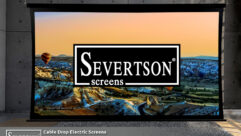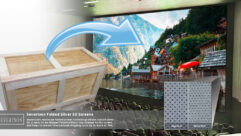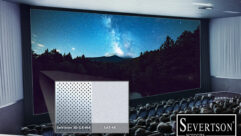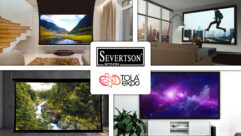
Technology Showcase: Front-Projection Screens
Apr 1, 2004 12:00 PM,
By Nick Dager
the Screen Works Perm screen
The image quality of projectors and other display devices has improved dramatically in recent years. This has fostered an increased demand for projection screens that keep pace. Fortunately, projection screen manufacturers have been up to the challenge, and the market today offers a projection screen for literally every application imaginable. If, somehow, the precise projection screen to meet your needs isn’t on the market, essentially every projection screen manufacturing company in the industry will custom-build what you require.
THE BASICS
There are two basic types of projection screens: front projection and rear projection. Front-projection screens are the most common for a variety of reasons, and they’re used to display the image from a projector. Rear-projection screens offer some advantages over front-projection screens but tend to be more expensive, and most important, they require dedicated space in a room. The image in a rear-projection screen comes from behind the screen. In this article, I will focus on front-projection screens. Beyond the basics, there is an almost limitless variety of screen types and sizes to choose from.
Da-Lite Da-Snap

CHOOSING A PROJECTION SCREEN
Most often a front-projection screen is the better choice because it offers more flexibility. These screens do not require the construction of a dedicated booth. The advantages of rear-projection screens are clear, of course; they don’t require unreasonable dimming of the room lights. Also, without the possibility that someone will block the projected image, people can interact as they do in normal meetings. As a general rule, rear-projection screens tend to produce a better image, and the noise of the equipment is diminished because it is in another room.
With front-projection screens, though, users can decide whether the screen should be fixed or portable. That decision largely rests on a company’s needs. The choices are portable, wallmounted, or ceilingmounted. If the projection application is permanent, wall- or ceilingmounted is the best choice. If projection applications will move from room to room, portable is the better choice.
Room dimensions, the size of the intended audience, and the seating arrangement of the room should determine the size of the screen.
The ideal screen height is one-sixth the distance from the screen to the last row of seats. That allows everyone in the room to view the text and picture easily. The first row of seats should be set back a distance roughly twice the height of the screen. The screen bottom should be at least four feet above the floor. Higher is better.

Choosing the screen’s surface can be more complicated, and there are trade-offs to consider with every choice. Again, the decision should be based on how the projection system will be used. The main idea is to match the surface to your particular projection source and lighting conditions. For front projection, matte white is the most popular choice for screen surface. It delivers excellent definition for finely detailed images and provides good images from color slides and overheads.
Smooth silver or white pearlescent surfaces are good for video or computer projection, but overheads can cause hot-spotting. Glass-beaded surfaces offer a brighter image but sacrifice sharpness. They are suited for general video, slide, and film projection use but are not recommended for computer data. Lenticular surfaces are a good choice for rooms with light from side windows, and they work well with video and slide projection but not with overheads.
Gain is the measure of a screen’s ability to collect a projector’s light and to direct it to specific locations. That is another consideration to make when choosing a screen. A high-gain screen is suited for rooms in which you want the lights to stay on during meetings so that people can see well enough to converse and take notes. Matte white screens typically have a gain rating of approximately 1.0. Glass-beaded screens are generally rated around 2.5, lenticular-surfaced screens range in gain from 1.5 to almost 3.0, and rear screens deliver gain ratings as high as 5.0.
Another factor in selecting a projection screen is its viewing angle, and it’s important to keep in mind that there is always a trade-off between gain and viewing angle. This relates to the fact that there is simply a limit to the amount of light a screen and projector can deliver. In general, if the viewing angle is narrow, the image will be brighter; if it is wider, the image brightness will be diminished accordingly.
Draper Salara

The flatness of a projection screen is important, especially if it will be used to display computer text. Flatness is not a problem with most front-projection screens, but it really becomes an issue with wall screens — large ones, in particular. Tension systems are available to help with this.Finally, choosing a screen with a black border can be of great benefit. A black border provides a clean edge for the projected image and helps eliminate washout. It can often deceive the viewer by making the image seem brighter and more colorful than would be the case with a screen without such a border.These are the basic issues to consider in selecting a projection screen. As always, more detailed information can be obtained from a systems integrator or a manufacturer to determine the right projection screen for your operation. Here is a rundown of offerings from the prominent manufacturers of projection screens.MANUFACTURER RESOURCESAV Stumpfl offers a range of frame systems for projection screens, including the System 64 Monoblox for large-scale projection screens. The system, which features newly developed snap joints, is designed to provide the stability needed for large mobile projection screens up to 24 feet. Folding joints attached at the inner side of the frame avoid unwanted shadows during rear projection.Bretford’s Series 100 is a versatile, manual multimedia wall screen designed for any classroom or office. A tensioning bar runs vertically along the back of the screen surface to tighten the projection surface and eliminate waves. The Series 100 is suited for data and video projection. The screen may be mounted directly on the wall or hung from the ceiling with built-in mounting rings. It comes with its own 4-inch mounting brackets to hold the screen away from the wall in order to make space for the built-in tensioning bar. The Series 100 is available in a variety of sizes and comes in a matte white fabric suited for general purposes such as classrooms or training rooms. It has black borders on all four sides for enhanced contrast. Because different hardware is required for different wall types, mounting hardware is not included.Among Da-Lite Screen’s many projection screen offerings is the Da-Snap, which is suitable for mounting on a wall or into a wall opening. It attaches with snaps or with optional Velcro. The Da-Snap surface mounts to the back of a black powder-coated frame that provides a masking border. The frame is available with Da-Lite’s Pro-Trim finish for an additional charge. Pro-Trim is a fabric frame covering that is designed to enhance the appearance of the installation while absorbing light that surrounds the viewing area. The Da-Snap comes in a wide range of surfaces and is available in seamless screens as large as 12 feet high.Draper’s newest motorized projection screen, the Salara, combines a distinct case design and innovative mounting and control systems designed to cut installation time. The Salara is for a variety of applications, from home theaters to conference rooms. It comes with a 10-foot power cord and plugs in to a standard electrical outlet. The screen can be controlled by a wireless wall switch or through remote control. The Salara is available in NTSC, HDTV, and wide-screen formats and with a variety of viewing surfaces.Elitech International USA has a range of motorized projection screens that range in sizes from 60 inches to 200 inches. The screens can be raised and lowered by a remote control that operates within 30 feet. Many screen fabrics are available, including matte white, glass bead, and pearlescent. The screens have a gain rating of 1.0 or 2.0, depending on materials and viewing angles from 30 degrees to 50 degrees. Nonstandard sizes are also available.Hurley Screen Corp. features the ElectraView Focus and the ElectraView Vision projection screens for a range of applications that includes conference rooms, schools, and home theaters. In-tube motors, an option with some manufacturers, are standard with all Hurley power projection screens. Unlike endmounted motors, in-tube motors allow for a smaller, lighter-weight case that centers above the screen so it can be centered on a wall. The ElectraView Focus is lighter-weight, features a 22-gauge galvanized steel case and a lightweight aluminum roll-up tube, and comes in a variety of finishes. All Focus models include a noise-reduction system. The Focus comes in two basic models, which can be made in custom sizes up to 12 by 12 feet. The larger ElectraView Vision is housed in a composite wood and galvanized steel-reinforced case with a steel roll-up tube. It is available in a variety of finishes. The wood structure lets the ElectraView Vision model screen be custom-sized up to 28 by 21 feet. The Vision also includes a larger, heavy-duty in-tube motor. Supported (nontensioned) and unsupported (tab-tensioned) surfaces are available. The viewing surface is laminated to a woven fiberglass base. This base provides flatness in the screen with little or no tensioning.PCM’s Flexscreen Scissor Support Wall Screen rotates and inclines to any desired position. A scissor action support at the rear of the screen provides a taut, smooth surface. The screen automatically adjusts to square and video formats and comes in a variety of sizes.Reversa Screens offers the Eclipse front-projection screen, which has a gain rating of 5.8 and a viewing angle of 175 degrees. Reversa says the Eclipse is ideal for boardrooms, home theaters, and especially retail windows because of its low light saturation. The Eclipse has a contrast ratio of 150:1 and is available in the 4:3 aspect ratio in sizes from 50 to 142 inches.Screen Research’s ClearPix range of fixed-frame video projection screens allows for excellent image quality and sound. The frame is available with ClearPix1 and ClearPix2 fabrics. These patent-pending fabrics allow speakers to be placed directly behind the screen with no sound or picture quality compromise. Instead of using snaps or Velcro, the screen fabric is stretched evenly through self-tensioning V-shaped grooves. A spring-tensioned insert grabs the fabric and locks it firmly into the frame with no bowing or creasing to ensure a flat surface. A range of dedicated accessories is provided to facilitate installation. Specific sizes are available through Screen Research’s custom program.The Screen Works offers the POP series of point-of-purchase front-projection screens in a range of surfaces that includes matte white, medium contrast, and black. Gain ratings measure from 0.8 to 8.0, depending on which surface is selected. The screens are all 3 mm thick and weigh less than 8.8 pounds. The viewing cone for the screens is 150 degrees for the black surface and 180 degrees for medium contrast. Matte white surfaces are available with viewing cones of both 180 degrees and 150 degrees. The Screen Works’ Perm screen uses the same 1-inch frame as its portable E-Z Fold Screen, which is assembled using easy-to-operate snap-lock joiners. The frame mounts to a wall using brackets, and both front- and rear-projection surfaces snap to the frame easily.Stewart Filmscreen Corp.’s new FireHawk flexible front-projection screen is for businesses, churches, and anywhere ambient light is prevalent. Stewart says the FireHawk increases black levels, shadow detailing, and color saturation. Screen brightness is claimed at a peak footlambert of more than 40 percent over all existing gray screens. The screen also preserves image contrast by dampening room cross-light reflection as much as 90 percent. The screen has a gain rating of 1.35 and a viewing angle of 100 degrees. The FireHawk is available in retractable and fixed screen models.Trac Associates’ LumenStar front-projection screen boasts a contrast ratio of 500:1, and as a result, the company says it can deliver dynamic images even in an environment with a lot of ambient light. The LumenStar is less than an inch thick and can be mounted on a wall, hung in the middle of a room, or used with a freestanding base. It is available in 4:3 or 16:9 aspect ratios in sizes from 40 inches to 120 inches. Multiple displays can be used to configure larger sizes. Using light-intense Optical Polymer Technology, Trac’s Lumin Silver projection display is also for projections in high ambient light environments. Available in almost every size and aspect ratio, the Lumin Silver can be shaped and formed to any designer’s needs. The homogeneous, nonstructured display surface is tough, resistant, and weatherproof.Vutec Corp. added an RF wireless remote-controlled screen to its family of motorized screens. With RF consumers can control the raising and lowering of the screen by wireless remote control without having direct line of sight with the receiving sensor. This is a major advantage when the desire is to conceal the electronic equipment from view, and the optional wireless battery-operated wall switch acts as a backup control. The Lectric I RF includes an AC wall plug for fast motorized screen setup and supports a variety of projection screen fabrics, including matte white, SoundScreen, and Vutec’s Vu-Flex Pro. The new SilverStar series is claimed to achieve high gain, high contrast, and color purity in ambient light.Gather as much information as possible about the projection screens that meet your needs. From here a good place to start is a visit to any of these projection screen manufacturers’ Web sites.Nick Dageris the editor and publisher of Digital Cinema Report, an online news service about wide-screen production and presentation.For More InformationAV Stumpfl USA Corp.
www.stumpfl.comBretford
www.bretford.comDa-Lite Screen Company
www.da-lite.comDraper
www.draperinc.comElitech International USA
www.elitechusa.comHurley Screen Corp.
www.hurleyscreen.comPCM
www.pcmlimited.comReversa USA
www.reversa.tvScreen Research
www.screenresearch.comThe Screen Works
www.thescreenworks.comStewart Filmscreen Corp.
www.stewartfilm.comTrac Associates LLC
www.tracassociates.comVutec Corp.
www.vutec.com










